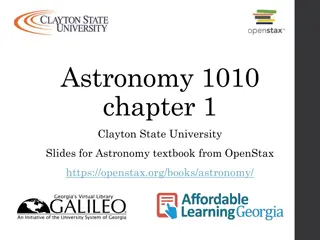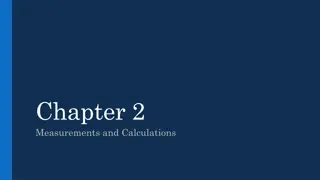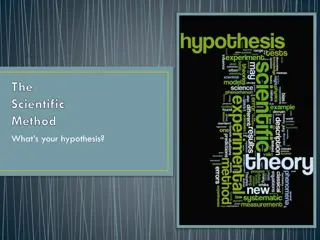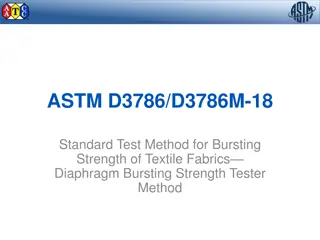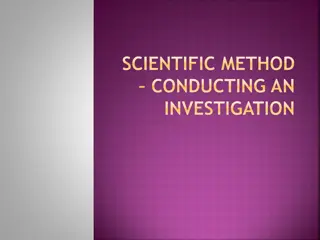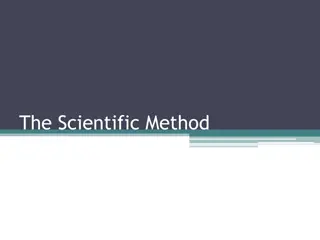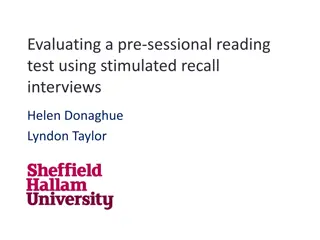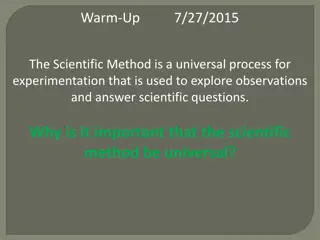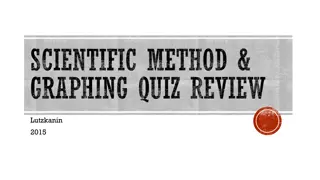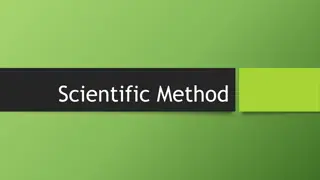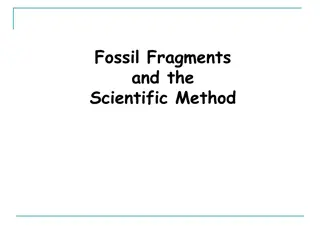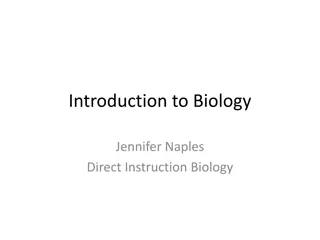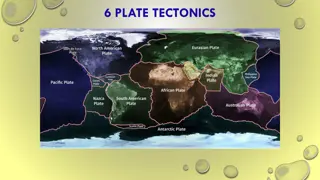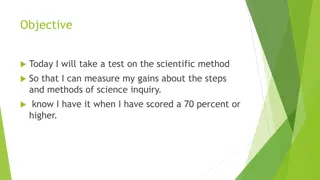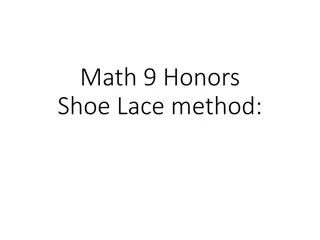Understanding the Scientific Method: Pre-Test and Daily Agenda
Explore the process of science with a pre-test on the scientific method, followed by a detailed daily agenda covering activities like bell-ringers, reviews, and experimental design. Understand the nature of science, scientific reasoning, and the importance of variables, groups, and constants in investigations. Dive into the dynamic nature of scientific knowledge and the continuous evolution of theories in the scientific community.
Download Presentation

Please find below an Image/Link to download the presentation.
The content on the website is provided AS IS for your information and personal use only. It may not be sold, licensed, or shared on other websites without obtaining consent from the author. Download presentation by click this link. If you encounter any issues during the download, it is possible that the publisher has removed the file from their server.
E N D
Presentation Transcript
Bell-Ringer 08.20.2014 Please get the paper at the back sink that is labeled bell- ringer. Complete the questions on your own. This is a pre-test. When finished turn your paper over. You may read a book whiles waiting for your classmates
Daily Agenda Minutes Activities 10 min Bell-ringer 10 min Daily Review 10 min Scientific Method PowerPoint 45 min Scientific Method Stations 10 min Closure
Objectives: I will sequence the steps of the scientific method. I will define the vocabulary associated with the scientific method. I will create flashcards for the vocabulary. I will identify variables, groups, and constants. I will design an experiment containing variables, groups, and constants.
Standards of Learning for Biology: BIO.1The student will demonstrate an understanding of scientific reasoning, logic, and the nature of science by planning and conducting investigations in which b) hypotheses are formulated based on direct observations and information from scientific literature; c) variables are defined and investigations are designed to test hypotheses; k) differentiation is made between a scientific hypothesis, theory, and law;
Science & the Scientific Method
What is Science? Science is the attempt to put the universe in some kind of order that humans can understand. From Latin scire (which means to know )
What do I need to know about the nature of science?
Science is constantly changing!
Science is constantly changing! Scientists verify each other s work. Every once in a while, the scientists find that a theory or scenario does not always hold true . So what then?????
SCIENCE MUST CHANGE TO FIT THE NEW FINDINGS. This is why Science is constantly changing.
Here are some famous scientists Albert Einstein Germany- 1879 Physicist Theory The Germ Louis Pasteur France- 1822 180px-Louis_Pasteur
And more famous scientists Ts ai Lun China -105 A.D. Paper Beatrix Potter England -1866 Mycologist and Author 225px-Cai-lun Image:Beatrix Potter1.jpg
And more famous scientists Benjamin Banneker United States- 1731 Farmer s Almanac & wooden clock Rosalind Franklin England- 1920 x-ray crystallography of DNA Rosalind Franklin
And more famous scientists Archimedes Greece-287 B.C. Density of an irregular object Miguel Servet- Spain 1511 Function of pulmonary system Michael Servetus
Scientists can be of any age, race, gender, religion or culture!
And.. Scientists rarely work alone... They are much happier working in groups!
So far we know Science is constantly changing Scientists can be from any race, gender, age, culture or religion. Scientists like to work in groups!
So, How Do We Study Science?
We use the Scientific Method!!!
Step 1: Identify a problem Ask a question.
Step 2: Research the Problem Look at reliable sources Determine what is already known about the problem. Write this under Background Information in the lab write-up.
Step 3: Form a Hypothesis Hypothesis- a testable explanation of an observation A hypothesis is NOT just an educated guess about what you think will happen. It must be TESTABLE!!!!
Step 4: Design an Experiment How are you going to test your hypothesis? You Design an Experiment!
Step 5: Test your hypothesis Follow a procedure Keep the procedure the same every time!
How many times should you repeat the trials to make sure your experiment is valid?
Step 6: Organize your data Put your data into a data table Independent Variable _____(unit) Levels Dependent Variable __________ (unit) Trial 1 Trail 2 Trail 3 mean range
Step 6: Organize your data Make the data table into a graph Graphs make it easier to see patterns in the data.
Step 6: Organize your data DRY MIX Dependent Variable = Responding Variable = Y axis Manipulated Variable = Independent Variable = X axis
Step 7: Draw Conclusion(s) Was your hypothesis correct? If your hypothesis was not accurate or if you think there was an error collecting data Start over and re-do experiment!
Step 8: Communicate Results Tell the scientific community what you discovered!
Bellringer This car will not start 1.What are some possible reasons the car will not start? 2.How would you test your guesses?
Scientific Method 1. Observation: Notice there is a problem or question to be answered 2. Hypothesis: Scientific Explanation 3. Experiment: Test your hypothesis 4. Data: Collect information -5. Analyze Data 6. Modify if needed or Communicate Results
Experiment Control: used to compare experimental results. Does not receive any experimental treatment/changes Variable: Factor changed during experiment Independent Variable: What do you change Dependent Variable: what do we measure
Control, Variables, and Constants Control: What is used to COMPARE the results to. It is the variable in which no independent variable has been applied. Variable: Anything that changes in an experiment. There are 2 types: Independent: What you change on purpose (cause) Dependent: What you observe changing, or What you measure/observe (effect) Constant: Anything that stays the same in an experiment to make sure that only the Independent Variable is being changed.
Data Qualitative Data: Express with Numbers -Quantitative Data: Express with Descriptions Display in graphs: Bar, Line, Circle X axis: Independent Variable Y axis: Dependent Variable
Analyze Results 1. If results are consistent with hypothesis, communicate and publish results. 2. If results are not consistent with hypothesis, modify experiment.
Conclusion 1. Experiment must be repeatable. 2. Theory versus Law -Theory is subject to change as more knowledge is gained. Theory of Evolution -Laws are universally accepted to be true. Law of Gravity
Everyday Science Scientific Method in everyday Car will not start =____________ Out of gas? = _________________ Adding gas and seeing if car starts = ___________________________ Car doesn t start = _____________ 1. 2. 3. 4. It wasn t out of gas = _____________________________ (disproves hypothesis this time) 5. Tada! The Five Steps of the Scientific Method
Everyday Science Scientific Method in everyday 1. Car will not start =Observation 2. Out of gas? = Hypothesis 3. Adding gas and seeing if car starts = Experiment 4. Car doesn t start = Data/Results 5. It wasn t out of gas =Conclusion/ Revise (disproves hypothesis this time)
Station 1:Identify parts of experiments including: Independent Variables Dependent Variables Experimental Group(s) Control Group Constants
Station 2: Create flash cards and study will them with a partner Independent Variables Dependent Variables Experimental Group(s) Control Group Constants Scientific Method Theory
Station 3: Design the experiment Choose one of the questions below and design an experiment to determine the answer. You must make a hypothesis, determine an independent variable, dependent variable, control group, experimental group(s), and at least 3 constants
Station 4: Create a Study Sheet Fill the space below with important words, phrases, or images that you think you should study for your quiz. You must fill the entire page and use at least three colors.
Station 5: Finish Lab Safety Projects If you have not finished your laboratory safety project you need to complete it by the end of class. No if, ands, or buts.




